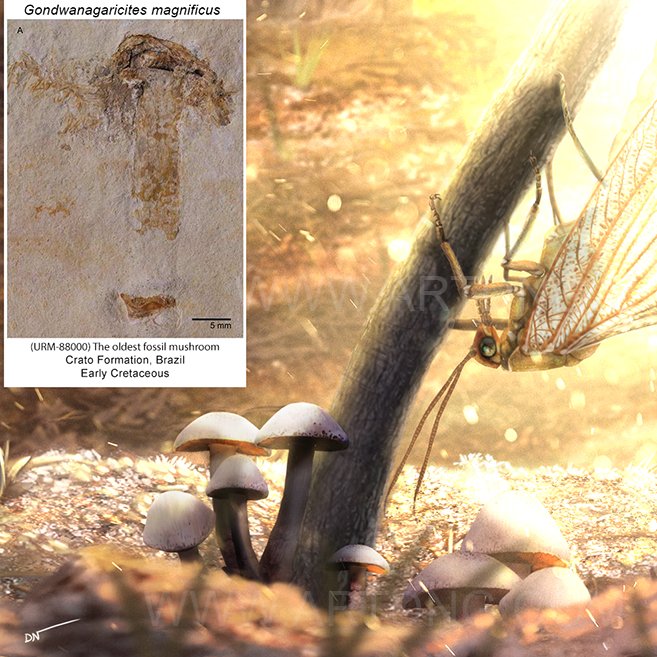Gondwanagaricites magnificus represents the oldest fossil mushroom to date and the first fossil mushroom from the ancient supercontinent Gondwana.

The gilled mushroom Gondwanagaricites magnificus lived during the Early Cretaceous, a time of dinosaurs when Gondwana was breaking apart. Image credit: Heads et al, doi: 10.1371/journal.pone.0178327.
Gondwanagaricites magnificus was about 2 inches (5 cm) tall and grew 115 million years ago (Early Cretaceous epoch) in what is now northeast Brazil.
The specimen was found in the limestone of the Crato Formation in Brazil’s Araripe Basin.
The find is described in new research published this week in the journal PLoS ONE, led by paleontologist Dr. Sam Heads of the University of Illinois at Urbana-Champaign.

Electron microscopy revealed that Gondwanagaricites magnificus had gills under its cap, rather than pores or teeth, structures that release spores and that can aid in identifying species.
Dr. Heads and his colleagues from the University of Illinois at Urbana-Champaign and Savannah State University place the mushroom in the fungal order Agaricales.

Gondwanagaricites magnificus was uncovered in the Araripe Basin, in northeast Brazil. Image credit: Danielle Ruffatto.
“Gondwanagaricites magnificus represents the oldest fossil record of a gilled mushroom and is the only fossil mushroom known from a mineralized replacement,” they explained.
“The unique specimen extends the geological range of gilled mushrooms back by approximately 14-21 million years and confirms their presence in Gondwana during the Early Cretaceous.”

According to the authors, the mushroom somehow made its way into a saline lagoon, sank through the stratified layers of salty water and was covered in layer upon layer of fine sediments.
In time — lots of it — the mushroom was mineralized, its tissues replaced by pyrite (fool’s gold), which later transformed into the mineral goethite.

The newly-discovered mushroom fossil is the oldest ever discovered; all others have been found in amber. Image credit: Danielle Ruffatto.
“Before this discovery, the oldest fossil mushrooms found had been preserved in amber,” said co-author Dr. Andrew Miller, also from the University of Illinois at Urbana-Champaign.
“The next oldest mushroom fossils, found in amber in Southeast Asia, date to about 99 million years ago.”
“They were enveloped by a sticky tree resin and preserved as the resin fossilized, forming amber,” Dr. Heads added.
“This is a much more likely scenario for the preservation of a mushroom, since resin falling from a tree directly onto the forest floor could readily preserve specimens. This certainly seems to have been the case, given the mushroom fossil record to date.”
Source: sci.news








